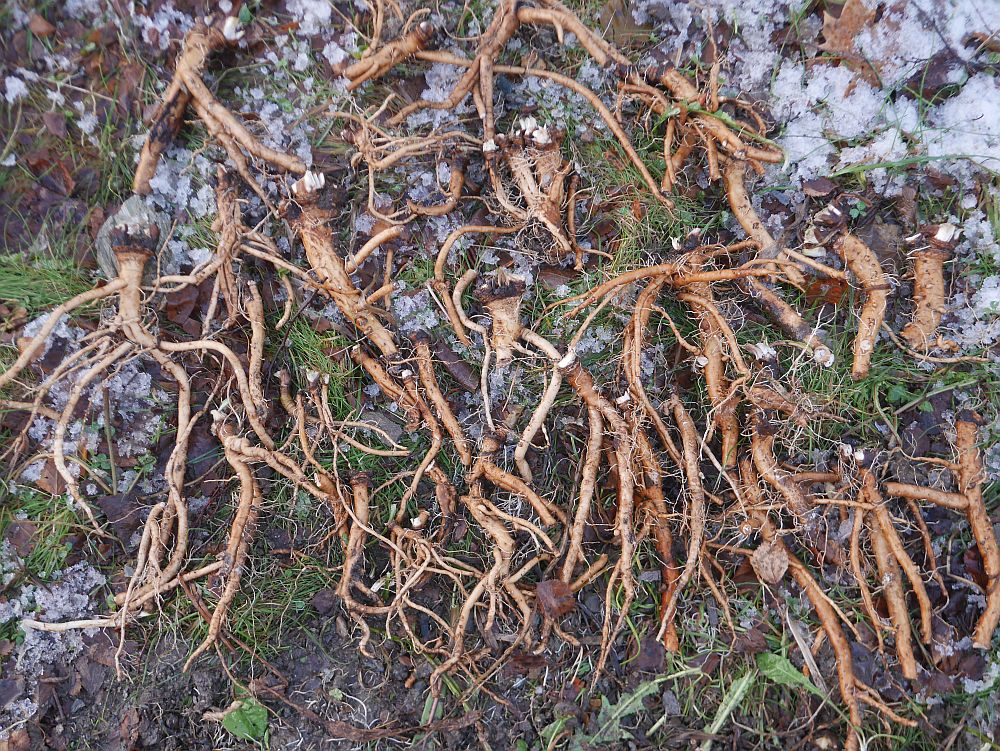We occasionally eat wild fish and bacalhau is a favourite made from Norwegian dried cod that can be found in supermarkets here. More or less anything goes in bacalhau (bacalao) and although most people make it in the same way – layers of potato, fish, tomato and onions, often with chili – the Portuguese have hundreds of ways of preparing baccalao (dried cod). Being self-sufficient, detailed recipes aren¨’t useful and we use whatever is available at the moment. Winter is the time for stored bulbs, corms, tubers, rhizomes, and taproots. See below the picture for yesterday’s baccalao ingredients with 14 home grown below surface storage organs plus some greens (I’m pretty sure nobody else had this version of the dish…ever!):
Oca (Oxalis tuberosa): yellow and red varieties
Garlic / hvitløk (Allium sativum)
Wapato (Sagittaria latifolia)
Potato / potet (Solanum tuberosum) – 2 varieties
Jerusalem artichokes / jordskokk (Helianthus tuberosus)
Parsnip / pastinakk (Pastinaca sativa)
Scorzonera / scorsonerrot (Scorzonera hispanica)
Common onion / kepaløk (Allium cepa)
Cacomitl (Tigridia pavonia)
Yacon (Polymnia sonchifolia)
Burdock / storborre (Arctium lappa)
Madeira vine (Anredera cordifolia)
Parsnip / pastinakk (Pastinaca sativa) shoots – had started shooting in the cellar
Leaf beets / bladbete (Beta vulgaris var. flavescens) – 3 varieties
Allium nutans (forced in the living room)
plus (not home grown) organic tomatoes, olive oil and olives
(I forgot the dandelion…will add tonight: we make enough that it lasts for several days….and the taste improves!)
Tag Archives: parsnip
Xmas diversity from the rhizosphere
Presenting this year’s 30 rhizosphantastic Xmas vegetables, all roasted in the oven, served as every year in the last 40 with nut roast, bedecked with the following seeds / bulbils: alpine bistort / harerug (Polygonum viviparum), Himalayan balsam / kjempefringfrø (Impatiens glandulifera), evening primrose / nattlys (Oenothera biennis) and opium poppy (Papaver somniferum). The tubers are listed below the pictures.



The 30 tubers, roots and rhizomes in the picture are:
Solanum tuberosum (potato / potet: 11 varieties)
Daucus carota (carrot / gulrot)
Oxalis tuberosa (oca: 2 varieties)
Arctium lappa (burdock)
Scorzonera hispanica (Scorzonera / scorsonnerot eller svartrot)
Tigridia pavonia (cacomitl)
Pastinaca sativa (parsnip / pastinakk)
Beta vulgaris (beetroot / rødbete)
Tropaeolum tuberosum (mashua)
Anredera cordifolia (Madeira vine)
Helianthus tuberosus (Jerusalem artichoke / jordskokk : 3 varieties)
Brassica rapa (turnip / nepe)
Brassica napus (swede / kålrot)
Dahlia (Dahlia / georginer)
Polymnia sonchifolia (yacon)
Sagittaria latifolia (wapato)
Allium cepa (onion)
Xmas day Rhizofantastigora dinner 2021
Xmas dinner in Malvik has been nut roast and roasted roots every year since 1984! This year there were 27 different roots: parsnip, 15 different varieties of potato, bulb onions, Tigridia (cacomitl), wapato (Sagittaria), carrot, beetroot, oca (red and yellow), Madeira vine (Anredera cordifolia), yacon (Polymnia), garlic (Allium sativum), Dioscorea polystachya (Chinese yam) and chicory root (at the top).
The nut roast was made from ground walnuts, hazelnuts and almonds with grated carrots, onion and beetroot with garlic, golpar (Heracleum seed spice), egg, salt, pepper and chili, bedecked with buckwheat groats (home grown by a friend in Czechoslovakia), Himalayan balsam seed, caraway, dill and alpine bistort bulbils (Polygonum viviparum).




Tubers and roots; December 2020
A gallery of pictures of tubers and roots which were harvested in December when I had a blog-free month!
Parsnip moth
If you grow parsnip (pastinakk) for seed, you may have come across the parsnip moth or parsnip webworm (Depressaria radiata) as it can make an impact on seed harvest as it makes a silk structure amongst the inflorescences. Here it’s on its other important host, hogweed (Heracleum spp.) which I’m also letting flower for the seeds (golpar spice).

19th March Veggies
Continuing my series of veggies harvested from the garden. this time used in a baccalao with parsnip (pastinakk), potato (potet), bulb onions .(kepaløk), Jerusalem artichokes (jordskokk), (bought) organic tomatoes and chili. Greens used from the garden:
Urtcia dioica (nettles/brennesle)
Aegopodium podograria (ground elder/skvallerkål)
Hablitzia tamnoides (Caucasian spinach/stjernemelde)
Rumex patientia (patience dock/hagesyre)
Taraxacum officinale dandichokes (dandelion /løvetann)
Ficaria verna (lesser celandine/vårkål)
Allium sativum shoots (garlic/hvitløk)


Parsnip men!
When my kids were young I made up a now legendary (in our family at least) story that I told them at bedtime about the Potato Men….potatoes that lifted themselves out of the ground at night in our garden and how they invaded the local area….
Well, it seems that there’s a parsnip men story in the making too….caught these in the garden about to escape! (or it could just be frost heave in the course of the winter!)
My biggest parsnip?
Another vegetable that there isn’t any tradition of growing here, despite the ease of growing it is broad bean (bondebønne), traditionally animal feed.












